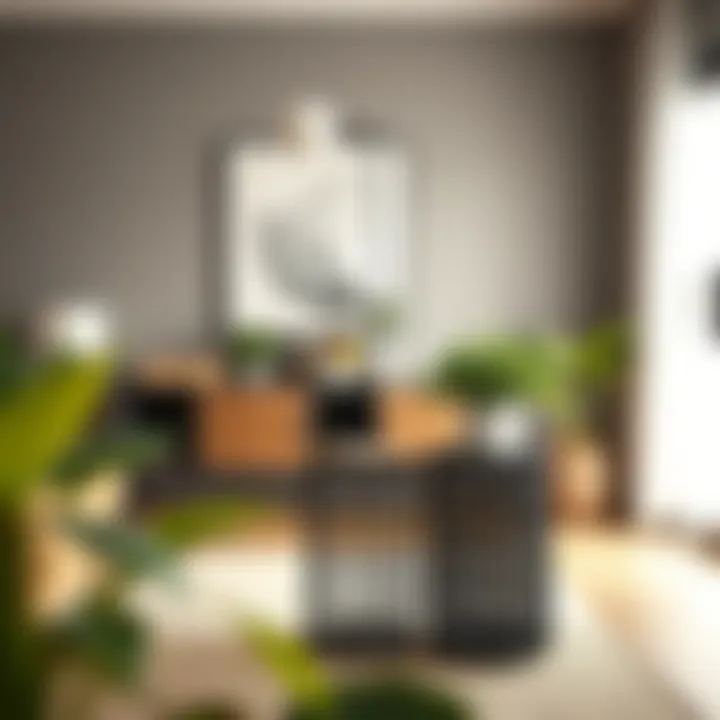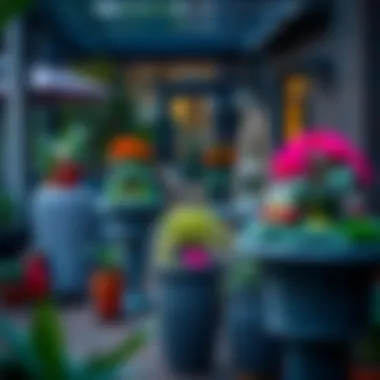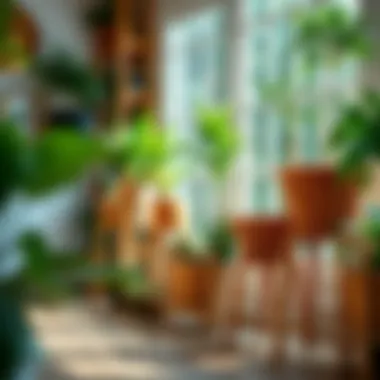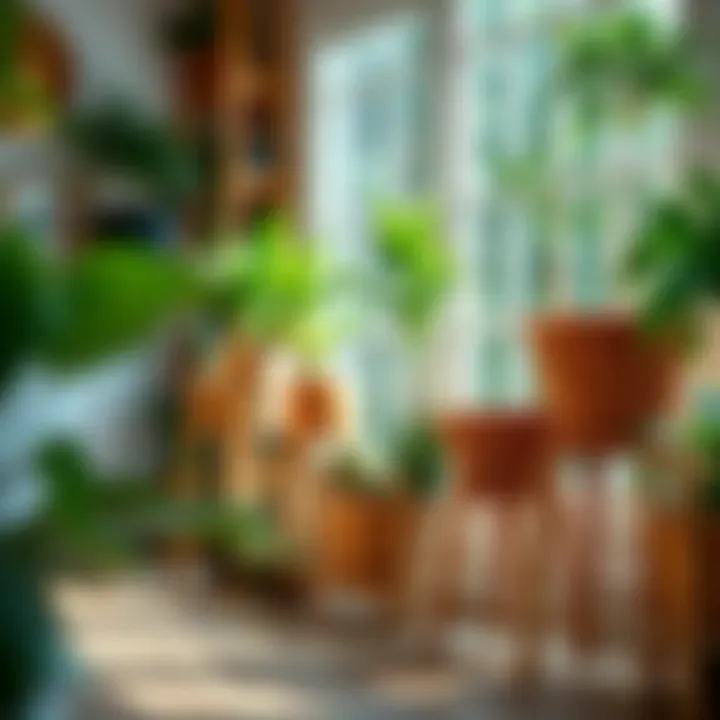Functional and Aesthetic Benefits of Plastic Wicker Plant Stands


Intro
In the realm of home decor, the selection of plant stands can have a profound impact on both the functionality and beauty of a space. Among the diverse range of materials available, plastic wicker stands are rapidly gaining popularity. They combine the appeal of traditional wicker with the practical benefits of plastic, making them an attractive option for both indoor and outdoor settings. This article will dive into the unique characteristics of plastic wicker plant stands and explore how they can elevate your interior and exterior design.
Through a structured analysis, we'll peel back the layers on material composition, practical benefits, aesthetic considerations, and maintenance tips. By the end, you will have a comprehensive understanding of how to select the right plant stand that not only supports your greenery but also enhances your decor.
Fashion Trends
Current Seasonal Trends
As the seasons change, so do the design trends and aesthetic preferences associated with plant decor. For instance, during spring and summer, the desire for light and airy designs takes center stage. Plastic wicker plant stands, with their illusion of woven textures, evoke a sense of nature while being incredibly versatile.
- Current trends highlight the affinity for organic shapes and soft hues. Think pastel greens, sandy beiges, or even terracotta tones. These colors not only harmonize with plants but also add a warm touch to spaces.
- Additionally, multi-tiered plant stands are making a big splash, allowing homeowners to maximize vertical space while creating a visually engaging display.
Influential Designers and Their Impact
Several designers have embraced the idea of incorporating plastic wicker into their collections. One such trailblazer is Patricia Urquiola, whose innovative designs often blur the lines between aesthetics and function. Her work with plastic materials has helped redefine perceptions, proving that practicality doesn't have to compromise beauty.
These influences are echoed in various interior design blogs and articles, where enthusiasts discuss new ideas and share personal design hacks. Platforms such as reddit.com offer community spaces where individuals can showcase their unique arrangements of plants, often using plastic wicker stands as key components.
The beauty of using plastic wicker plant stands lies in their versatility, easily fitting into various decor styles while remaining lightweight and durable.
Through the guidance of influential designers and the synthesis of current trends, plastic wicker plant stands are effectively reshaping how we view plant displays in our homes.
Aesthetic Appeal
A good aesthetic goes beyond looks; it encompasses the overall vibe of a setting. With their range of designs—from sleek, modern lines to more rustic appearances—plastic wicker plant stands can fit seamlessly into any design philosophy. Their woven texture introduces delightful visual interest, inviting a closer look while also providing a backdrop that allows vibrant plant life to stand out.
Maintaining a fresh and inviting environment requires choosing pieces that enhance the overall aesthetic without overcrowding a space. Due to their lightweight nature, these stands can be repositioned easily, allowing for seasonal redecorating that keeps spaces feeling dynamic.
Moreover, the ability to easily clean plastic wicker makes them suitable for both sunny patios and indoor spaces susceptible to spills or dirt.
In summary, plastic wicker plant stands are not just functional pieces; they're a style statement, offering a blend of elegance and utility. As we continue to explore their role in modern decor, it becomes clear that they hold significant value in enhancing the ambiance of any space.
Prelims to Plastic Wicker Plant Stands
In todays' rapidly evolving world of interior and exterior design, the allure of plastic wicker plant stands is captivating. These functional and visually pleasing pieces do more than just hold plants; they bring an element of sophistication to any space, whether it's cozy indoor corners or vibrant outdoor patios. Understanding their significance in contemporary decor is essential for anyone from designers to casual enthusiasts.
Plastic wicker plant stands possess a unique blend of practicality and beauty. The balance they strike between durability and aesthetic appeal makes them suitable for diverse environments, both residential and commercial. They not only serve the purpose of displaying plants but also act as part of the overall theme of a room or garden. As styles change and evolve, these stands offer versatile designs that can accommodate various tastes and preferences.
Moreover, the benefits of selecting plastic wicker over traditional materials are considerable. Lightweight and weather-resistant, they can be effortlessly moved, rearranged, or stored without hassle. This practicality does not compromise style, as the visual variety these products offer is extensive. From classic weaves to bold colors, there's something for everyone.
In this article, we will be diving into the definition of plastic wicker, tracing the historical roots of wicker design, and discovering how these stands have adapted and thrived in modern design landscapes. With this exploration, we aim to equip readers with the knowledge necessary to choose the right plant stands that harmonize with their aesthetic objectives and functional requirements.
Defining Plastic Wicker
Plastic wicker refers to the synthetic fibers that recreate the look and feel of traditional wicker but offer additional advantages. With origins deeply rooted in the need for durability, plastic wicker came about as a response to the downsides of natural materials. Unlike natural wicker, which can be susceptible to weathering and decay, plastic wicker is designed to withstand the rigors of daily use, especially in changing weather conditions.
This type of wicker is often composed of high-density polyethylene (HDPE), a material known for its resilience. HDPE mimics the visual intricacies of natural wicker, presenting textures and colors vibrant enough to enhance any setting. The appeal lies in conducting a psychological association with nature while circumventing the limitations presented by its natural counterpart.
Historical Evolution of Wicker Design
Wickerwork has a rich history that stretches back thousands of years, originating as a craft from ancient civilizations. From the Egyptians who used palm leaves to the artisans of the Victorian era who elevated wicker to new heights of intricacy, the craft has continually evolved.
The introduction of synthetic materials into this age-old craft in the mid-20th century marked a significant transition. As design trends shifted toward functionality and maintenance, the arrival of plastic wicker brought a promise of longevity. The durability of synthetic wicker became essential as outdoor living spaces gained popularity in the 1970s and 1980s. Traditional wicker couldn’t withstand the elements, and thus, plastic wicker emerged as a game-changer for those seeking a practical yet stylish solution.
In essence, the journey of wicker design reflects human innovation, illustrating how aesthetics and function can harmonize beautifully. As we examine modern plastic wicker plant stands more closely, it’s clear that they not only pay homage to this traditional craft but also redefine it for contemporary needs.
Material Composition and Properties


The material inside these plastic wicker plant stands is essential to their overall performance and look. Different kinds of materials can immensely influence their durability, aesthetic appeal, and even environmental impact. Everything relates back to how well these stands function, not just for the plant they hold but as part of the space they occupy.
Understanding Plastic Materials
When we talk about plastic wicker, we're often referring to high-density polyethylene (HDPE) or polypropylene. These materials are chosen for their sturdy nature while being lightweight. HDPE, for instance, has a long-standing reputation for standing up against the weather like a seasoned champion. It is unyielding to the sun's harsh rays, resistant to fading, and can brave heavy rainfall without crumbling under pressure. This resilience is not merely an accident; it's by design.
Additionally, plastic wicker stands boast a smooth surface that’s both tactile and visually appealing, allowing for a range of finishes and colors unmatched by natural materials. This versatility gives designers endless possibilities to play with, matching any decor style - from modern minimalism to rustic charm.
Comparative Analysis: Plastic vs. Natural Wicker
When we compare plastic to natural wicker, it’s like pitting the seasoned veteran against the up-and-comer. Natural wicker, often made from rattan or bamboo, has its own allure - warm, organic, and full of character. Yet, these traditional materials can come with their pitfalls. They are vulnerable to pests, decay, and aren’t exactly forgiving when it comes to weather exposure. If you place a natural wicker stand outside, you could find yourself dealing with warped pieces and mold.
In contrast, plastic wicker has a reputation for leniency and ease of care. Here’s a glimpse:
- Durability: Natural wicker may last a while, but it stands no chance against heavy rain or strong sunlight compared to its plastic counterpart.
- Maintenance: Plastic wicker simply needs a quick rinse or wipe-down from time to time, while natural wicker takes more tender loving care to maintain its charm.
- Design Flexibility: With the ability to mimic any style, plastic wicker can fit seamlessly into any design language, be it sleek or rustic, without the inherent limitations faced by natural materials.
However, one cannot ignore that natural wicker carries an inherent elegance, full of character which can be harder to replicate with plastic. Nonetheless, for those who prioritize practicality alongside good looks, there is value in leaning towards plastic wicker. Ultimately, the choice may boil down to individual preference, environmental considerations, and where the patina of nature finds its home in your aesthetic vision.
Aesthetic Appeal in Design
The aesthetic appeal of plastic wicker plant stands is more than just about looks; it plays a crucial role in how we perceive and interact with our living spaces. These plant stands can transform a mundane corner into a vibrant focal point, merging functionality with visual delight. The variety of designs, colors, and textures available allow for a unique expression of personal style, making them an increasingly popular choice for both indoor and outdoor settings. With the right choice, a plant stand can not only complement plants but also enhance the overall decor of the space, making them significant elements in design.
Color and Texture Variations
When it comes to plastic wicker, color and texture variations are vast. From earthy tones resembling natural materials to bright shades that can inject fun into a space, the options are abundant. The ability to mimic traditional wicker also allows for textures that evoke a sense of warmth or comfort.
- Versatile Colors: Plastic wicker can be dyed in any hue imaginable. Whether it’s calming greens that echo nature or vibrant reds that stand out, there's a shade for every palate.
- Rich Textures: Advances in manufacturing mean that plastic wicker can now achieve a hand-woven look. The varied surface textures can add dimension and depth, making an ordinary plant stand feel extraordinarily inviting.
Incorporating such variations can significantly influence the atmosphere of your interior or exterior areas. For instance, consider a sleek charcoal-colored stand against a white wall, creating a contemporary contrast that exudes sophistication.
Incorporating Plastic Wicker in Modern Decor
Indoor Plant Stands
Indoor plastic wicker plant stands are a fantastic way to liven up any room. Their lightweight composition makes it easy to reposition them, allowing homeowners to constantly refresh the look of their spaces without breaking a sweat. Moreover, these stands often feature various heights and styles that help in creating visual interest.
- Key Characteristics: Their design usually incorporates multiple tiers or unique shapes, offering not just support for plants but artful display options. This functionality elevates standard decor into tailored aesthetics.
- Popularity: The lightweight nature and stylish designs have made them a favorite among interior decor aficionados. They fit seamlessly with different decor styles, whether it’s minimalistic, mid-century, or even bohemian.
- Unique Features: Some indoor stands are designed with built-in drainage systems to protect surfaces from excess moisture. This practical characteristic adds to their appeal, as it reduces the risk of damage to flooring while maintaining the health of the plants.
However, it's essential to consider the weight capacity of these stands, especially for larger plants. Misestimating can lead to unfortunate accidents.
Outdoor Arrangements
Outdoor arrangements with plastic wicker stands bring an enchanting touch to gardens, patios, or balconies. These stands are designed to endure the elements, providing not only utility but also a significant aesthetic enhancement to outdoor settings.
- Key Characteristic: Many outdoor plastic wicker plant stands come with UV-resistant coatings, ensuring that the colors remain vibrant even in direct sunlight. This quality makes them an excellent choice for outdoor decor.
- Popularity: They work wonders in creating comfortable gathering spots, as planters filled with flowers can draw a crowd and enliven any outdoor gathering. Their stylish yet sturdy structure stands up well to the demands of outdoor life.
- Unique Features: Many are designed to be stackable, making them easy to store when not in use. This feature is particularly useful for those who have limited outdoor space.
On the flip side, while they boast resilient features, some may need periodic cleaning to keep their appearance tidy and inviting, especially after a rainstorm or a dusty day.
Overall, the integration of plastic wicker plant stands into various settings illustrates their dual role as both practical and decorative elements, underscoring their importance in modern design.
Functional Benefits
Understanding the functional benefits of plastic wicker plant stands is essential for those looking to enhance their indoor or outdoor spaces. These plant stands not only serve a purpose but also elevate the quality of plant care, making them a staple in contemporary design. Characteristics like durability, weather resistance, lightweight nature, and portability are keys to why plastic wicker stands are favored by fashion enthusiasts, designers, and retailers alike.
Durability and Weather Resistance
Plastic wicker stands are often praised for their durability. Unlike traditional materials, plastic wicker is engineered to withstand various environmental conditions. This resilience is particularly notable in outdoor settings where rain, sun, and fluctuating temperatures can wreak havoc on less robust materials.
For instance, consider the cliche of a beautiful wooden plant stand rotting away after a season of rain. On the other hand, a plastic wicker stand retains its form and color, making it an ideal choice for outdoor decor. The combination of UV-resistant treatment and high-grade plastics enhances longevity.
"Investing in plastic wicker is akin to choosing a weathered stone over a fragile leaf; one stands the test of time, while the other crumbles under pressure."


In addition to moisture resistance, the material's innate ability to resist fading means that colors remain vibrant even after extended exposure to sunlight. This is crucial for maintaining aesthetic appeal over time, especially when these stands are used in gardens or patios where visual harmony is paramount.
Moreover, plastic wicker is scratch and dent resistant. This characteristic becomes evident in high-traffic areas, where impacts from pets or outdoor activities can happen. When durability meets style, one can achieve functional decor that doesn’t compromise on looks.
Lightweight Nature and Portability
When it comes to moving plants around, the lightweight nature of plastic wicker stands is hard to beat. We all know that a heavy plant stand can make rearranging a space a daunting task. However, with the right tools—namely plastic wicker stands—one can easily shift plants to catch the sunlight just right or create a new focal point without breaking a sweat.
Portability is particularly advantageous for those who enjoy changing up their decor frequently. Imagine having a few indoor plants you wish to rotate depending on seasons or festivities. With lightweight plastic wicker plant stands, this process becomes a breeze.
The convenience does not stop with simple mobility. Consider hosting gatherings outside—being able to relocate table arrangements and plants seamlessly can transform an outdoor area into a customized celebration space. You can easily adapt to different aesthetics or needs, making these stands exceptionally versatile.
In practical terms, this means taking your beloved plants on trips or simply placing them where the sun shines best without the struggle. Whether you want to declutter your living room or need to make space for a new furniture piece, the adaptability provided by lightweight plant stands is invaluable.
Overall, combining durability with lightweight characteristics offers a double win for those embracing both functionality and aesthetics in their gardening and decor solutions.
Choosing the Right Plant Stand
Selecting the appropriate plant stand for your indoor or outdoor space is not just about aesthetics; it’s a dance of balance between functionality and style. A suitably chosen plastic wicker plant stand can enhance your decor, create focal points, and even contribute to the health of your plants. This section delves into the nuances of making the right choice, shedding light on various considerations to keep in mind.
Considerations for Indoor Use
When picking a plant stand for indoors, it’s crucial to take into account the overall theme of your space. Indoor plant stands are often used to complement interior design motifs. Here are a few specific aspects to ponder:
- Style Integration: The design should resonate with the existing aesthetics of the room. If your decor leans towards bohemian chic, a colorful woven plastic wicker stand could be a match made in heaven.
- Space Availability: Always measure the intended area before going shopping. You don’t want to bring home a stand that dwarfs your plants or, conversely, one so petite it gets lost in the corner.
- Light Considerations: Think about where natural light enters the room. A stand that is strategically placed near a window not only highlights your plants but ensures they receive the necessary sunlight.
Choosing wisely based on these considerations can significantly elevate the indoor environment.
Factors for Outdoor Selection
Outdoor plant stands face different challenges than their indoor counterparts, mainly due to exposure to the elements. Understanding these factors can guide you in making a robust choice:
- Weather Resistance: Seek out stands made from durable plastic wicker that can withstand rain or intense sun. Some brands might even offer UV-resistant finishes.
- Stability: Given that outdoor environments can be breezy, look for stands that maintain a low center of gravity for stability. Lightweight options may blow over easily, which is a hassle in a garden.
- Maintenance Ease: Outdoor plant stands can get dirty fast, so opt for materials that are easy to clean. Plastic wicker typically requires just a quick wipe down with soapy water, making it a sturdy choice.
By considering these factors, you can ensure that your outdoor plants not only look good but also thrive in their environment.
Size and Height Considerations
Size matters more than one might think in the world of plant stands. It’s not just about how the stand looks; it’s about ensuring it serves its purpose.
- Plant Size Matching: The height of your stand should correlate with the height of your plants. Taller plants look stunning on elevated stands, while smaller plants can be flattered on lower setups.
- Visual Balance: When grouping plants, consider varying the heights to create a layered effect. A mix of different sizes can turn a humble plant stand into a striking artificial garden.
- Footprint: Assess the floor space available. A large stand can overwhelm a small area, while a petite option might not provide enough presence in a sprawling room.
Finding the right size and height enhances the visual narrative of your green companions while providing them with the care they need.
Maintenance and Care
Maintaining the beauty and functionality of plastic wicker plant stands is crucial for longevity and aesthetic appeal. These stands act as more than just a base for your plants; they enhance the overall decor, particularly when chosen to complement your style. Regular maintenance ensures that they remain visually pleasing while retaining their structural integrity through various environmental conditions.
Cleaning Techniques for Longevity
Keeping your plastic wicker stands clean is a relatively easy task that can yield significant rewards. A simple mix of warm water and mild detergent usually does the trick. Here’s how to effectively clean them:
- Dust Regularly: Use a soft cloth or a duster to wipe away dust. This helps in maintaining their original look.
- Gentle Washing: For more rigorous cleaning, mix a few drops of dish soap in a bucket of warm water.
- Non-Abrasive Scrubbing: Use a soft-bristled brush to gently scrub any stubborn dirt or stains. Avoid using anything abrasive that might scratch the surface.
- Rinse Well: After scrubbing, ensure you rinse with clean water to remove any soap residue.
- Dry Completely: Allow the stands to air dry completely before placing them back in use. Moisture can lead to mildew or bacteria growth, undermining their appeal and integrity.
By keeping the stands clean, you also prevent grime build-up that could potentially stain or mar their finish. This basic upkeep is simple yet essential.
Protective Measures Against Wear and Tear
Plastic wicker is generally resilient, but like any material, it can experience wear and tear over time. Taking some precautionary measures can help ensure that your plant stands stay in top condition:
- Placement Considerations: Whenever possible, position your stands out of direct sunlight for prolonged periods. This can help prevent fading and brittleness caused by UV exposure.
- Use of Coasters or Mats: If your stands are under high moisture conditions, like around watering plants, consider using coasters or mats beneath them for added protection.
- Regular Inspections: Check regularly for any signs of damage. Small cracks or loose parts can often be repaired easily if addressed immediately.
- Storing Indoors Off-Season: For outdoor stands, store them in a dry, sheltered area during harsh weather to prolong their life.


"An ounce of prevention is worth a pound of cure." Taking small steps can prevent big issues later on.
By implementing these maintenance and care practices, the functional and aesthetic aspects of your plastic wicker plant stands can remain intact, ensuring they serve their purpose in enhancing your home environment.
Sustainability Considerations
Sustainability is more than just a buzzword; it's a call to action. As we navigate the complexities of our environment, understanding how our choices affect the planet becomes increasingly vital. When it comes to plastic wicker plant stands, sustainability considerations play a significant role in their design, production, and end-of-life management. Not only do these products serve an aesthetic purpose, but they also carry implications for both environmental conservation and resource management.
Recyclability of Plastic Wicker
One of the primary benefits of plastic wicker plant stands lies in their recyclability. Most plastic wicker materials are crafted from high-density polyethylene (HDPE) or polypropylene, which are both widely accepted by recycling programs. Unlike natural wicker, which is derived from plant materials, plastic wicker can be reprocessed into new products, reducing waste and slowing down the demand for raw material extraction.
"The more we recycle, the less we waste; every bit counts in preserving our planet."
If left unchecked, discarded plastic wicker can contribute to landfill overflow, so proper recycling habits are essential. Notably, many municipalities have systems that facilitate the recycling of plastic products. Enthusiasts of eco-friendly living should encourage local governments to enhance these initiatives. By opting for plant stands made from recyclable materials, consumers not only enhance their decor but also make a conscious choice towards sustainability.
Environmental Impact Comparisons
When contrasting the environmental impact of plastic wicker with natural materials, several factors emerge. While natural wicker is biodegradable, it necessitates the harvesting of live plants, often leading to deforestation and habitat loss. In contrast, the creation of plastic wicker stands lessens the demand for traditional wicker and shifts the burden onto petrochemical industries straddled between sustainability and fossil fuel consumption.
- Resource Consumption:
- Durability and Longevity:
- Natural wicker requires raw materials from specific plants, potentially leading to overharvesting.
- Plastic wicker utilizes recycled materials whenever possible, reducing the strain on new resources.
- Plastic wicker is designed to withstand weather extremes, which makes it a long-lasting choice with less frequent replacements needed.
- Natural wicker may decay or become brittle over time, thereby needing replacements sooner.
As both forms of plant stands bring their merits and disadvantages, the challenge is to adopt products that balance both aesthetic appeal and environmental responsibility. Plant stands made from plastics are certainly not a perfect answer, yet they can represent a step forward, especially if coupled with a consumer ethos that favors recycling and responsible usage. By examining the entire lifecycle of these products, one can appreciate the broader picture of sustainability in home decor.
Trends in Plant Stand Design
In the fast-changing world of home decor, staying abreast of trends in plant stand design is crucial. Not only do plant stands serve a functional purpose, they also play an aesthetic role in our living spaces. As we continue to blend innovation with tradition, awareness of trends allows designers, retailers, and plant enthusiasts to make informed choices that resonate with contemporary styles and sustainability.
Current Market Preferences
Today's consumers are more selective than ever when it comes to their decor choices. There’s a notable shift towards design that merges functionality and aesthetics. Here are some defining preferences shaping the market:
- Simplicity and Minimalism: Clean lines and uncomplicated structures reign supreme. A shift towards minimalist designs helps emphasize the beauty of the plants themselves without overwhelming them with ornate stands.
- Material Sustainability: Increased environmental awareness is favoring plant stands made from recycled or sustainable materials. Consumers appreciate products that are not just pretty but also eco-friendly. Plastic wicker, thanks to its recyclability, fits this bill splendidly.
- Versatile Styles: Customers are opting for multi-purpose stands that can seamlessly transition between indoor and outdoor settings. Lightweight yet sturdy designs are winning hearts for their practicality.
- Bold Colors and Textures: While neutrals are classic, there's a rising appetite for vivid shades and innovative textures. Plastic wicker plant stands now sport a multitude of color palettes that can elevate any decor style.
"The right plant stand acts as a silent partner to the plant, enhancing its beauty while standing on its own merits."
Design Innovations and Future Directions
As we peer into the crystal ball of design, several innovations emerge that may define the future of plant stands, especially those crafted from plastic wicker. Here are a few forward-looking trends:
- Smart Technology Integration: Imagine a plant stand equipped with sensors that alert you when your plant needs watering or even light conditions. Such technology could soon be commonplace, merging aesthetics with advanced functionality.
- Customized Designs: The era of cookie-cutter solutions is giving way to customization. Designers are beginning to offer personalized plant stands that allow consumers to choose colors, sizes, and styles that reflect their unique tastes.
- Biophilic Design Elements: Integrating nature into design is not just a fad; it’s a necessity for many. Expect to see more plant stands that include features mimicking natural landscapes or fostering plant growth, such as vertical designs that promote air circulation.
- Hybrid Materials: Mixing traditional natural elements with modern materials can attract a wider audience. This blending takes advantage of the aesthetic warmth of wood paired with the practicality of plastic wicker, offering the best of both worlds.
The End
The closing thoughts on plastic wicker plant stands encapsulate the vibrant interplay between functionality and aesthetics that these pieces offer in both indoor and outdoor settings. In a world where design meets utility, these stands serve as a perfect example of how innovation in materials can enhance our living spaces. The significance of this topic goes beyond mere style; it touches on practical benefits and sustainability considerations, making them an essential feature in contemporary design.
Summarizing Key Points
In summarizing, it is essential to highlight a few key aspects of plastic wicker plant stands:
- Versatility: They fit into various decor styles, from modern minimalist to bohemian chic.
- Durability: The resistance to weathering and environmental factors ensures longevity.
- Maintenance ease: Simple cleaning methods enable this decor to shine with minimal effort.
- Eco-conscious choices: Many brands focus on recyclable materials, supporting sustainability.
This means that selecting the right plastic wicker plant stand not only elevates the decor but also embodies a choice for an environmentally friendly future.
Future Outlook on Plant Stand Designs
Looking ahead, the future of plastic wicker plant stand designs appears promising. As design trends evolve, we may see:
- Enhanced customizability: Brands might offer options for colors, shapes, and sizes, allowing customers to personalize stands to their taste.
- Smart integration: With technological advancements, features such as built-in irrigation systems could become commonplace, further marrying technology with nature in garden design.
- Sustainable materials: Continuous innovation in material production can lead to more eco-friendly choices that do not compromise on aesthetics or functionality.
As consumers become more eco-aware, the demand for sustainable and stylish plant stands will likely increase, pushing manufacturers towards greener practices.
As plant-loving designers, retailers, and enthusiasts continue to seek out the perfect blend of style and practicality, plastic wicker plant stands will undoubtedly play an integral role in shaping the visual narrative of our homes and gardens.



